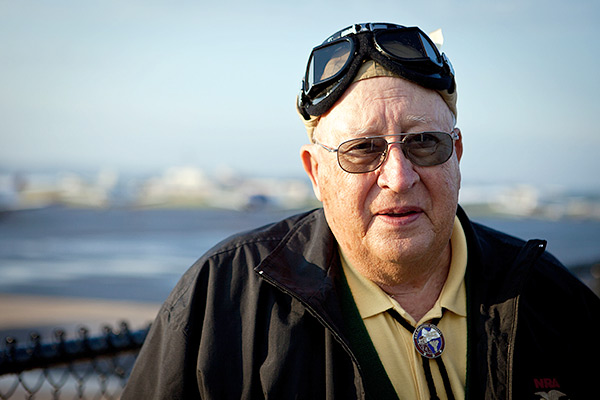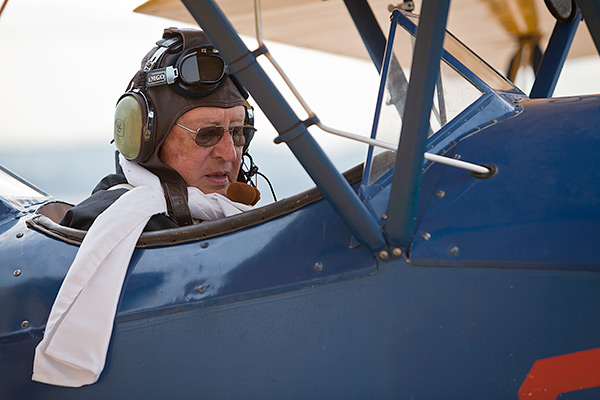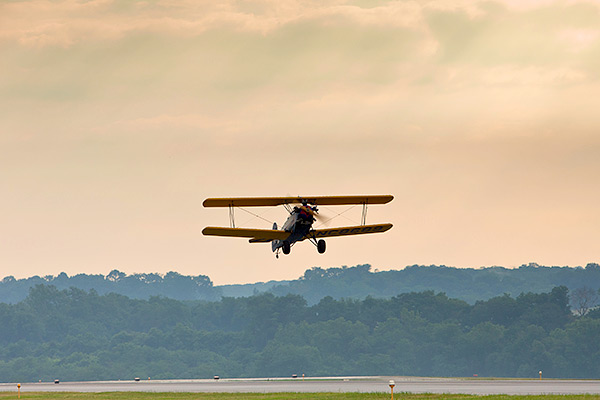
Plane Jane, a restored 1929 Fleet Model 2 biplane, made its last flight June 18 on its way to the Smithsonian's Steven F. Udvar-Hazy Center. Gene Breiner and daughter Joyce Breiner donated the aircraft to the Smithsonian.

Gene bought the Fleet Model 2 in 1978. He had found the fuselage frame at Blue Swan Airport in Sayre, Pa., and drove to garages around the area to collect the rest of the pieces. The wings were in a barn 30 miles downriver, he said.

Powered by a five-cylinder Kinner radial engine, the Fleet Model 2 is a smaller version of the military PT-3 trainer. It was designed specifically for civilian training prior to World War II.

Gene leaves his mark on the airplane. While it is meticulously restored to its condition in 1939, the Model 2 bears evidence of its life after restoration on the insides of engine access doors.

Gene and Joyce read a letter from Gene's grandson to restorers. Both of his grandsons had a chance to receive half an hour of instruction in the Fleet Model 2 before they delivered it to the Smithsonian.

Hundreds of student pilots flew the Fleet Model 2, Serial No. 75, during its time at the Roosevelt Aviation School in Long Island from 1929 to 1942.

Gene said the airplane is light on the controls and well rigged, making it an ideal airplane for advanced students at Roosevelt Field. "You can do all the maneuvers with two fingers," he said.

The restored Fleet Model 2 Plane Jane is an 18-time medal winner at fly-ins across the East Coast, according to the Smithsonian.

Gene hugs his daughter Janet before his last flight in Plane Jane.

Gene prepares for takeoff. His friend John Machamer, who has begun restoring another Fleet 2, Serial No. 61, joined him in the rear cockpit for the last flight.

The Fleet takes off from Runway 23 at Frederick Municipal Airport. The aircraft has no radio and was escorted by a Citabria into the Washington, D.C., Special Flight Rules Area for its trip to Dulles for Become a Pilot Day.
Four low-and-slow taildraggers lined up to depart Runway 23 at Maryland’s Frederick Municipal Airport. Led by a 1929 Fleet Model 2 biplane, the procession was an unusual sight for Washington, D.C.’s highly restricted airspace as it made its way to Washington Dulles International Airport to mix with jetliners on the tarmac.
The aircraft—the Fleet, a 1930 Waco RNF, a Citabria, and a Cessna 120—were more at home at eastern Pennsylvania grass strips, but they were on a very important mission: to deliver the Fleet to its new home at the Smithsonian’s Steven F. Udvar-Hazy Center on Become a Pilot Day June 18. It was the Fleet’s last flight.
With restorer Gene Breiner in the front cockpit and pilot John Machamer in the rear, the airplane taxied onto the runway, accelerated with a putter of the five-cylinder Kinner radial engine, and lifted off to take its place in American aviation history.
The Fleet Model 2, Serial No. 75, left the factory in 1929 and spent more than a decade at Roosevelt Aviation School on Long Island’s Roosevelt Field. The aircraft—the only surviving Roosevelt Field trainer, according to the Smithsonian—spent decades in pieces before A&P mechanic and FAA maintenance inspector Breiner hauled the fuselage from its hangar, collected boxes of parts from garages around eastern Pennsylvania, and picked up the wings from a barn in 1978. He spent years meticulously restoring it to its historical condition as a pre-World-War-II trainer and then flew it from 1985 to June 18 this year, along the way making history of a more personal sort. He and daughter Joyce Breiner donated it to the Smithsonian at the museum’s Become a Pilot Day.
Double-winger
Breiner came across the Fleet’s fuselage frame in a hangar at Blue Swan Airport in Sayre, Pa., shortly after leaving the Air Force in 1952, he said. He had just started a maintenance shop at Danville, Pa., and was looking for an aircraft to re-cover as a winter project—and he had always wanted a biplane.
“We joked, ‘You haven’t flown until you’ve flown a double-winger,’” he said.
He asked about buying the airplane, but the owner said he had plans to rebuild it. Breiner moved to Richmond, Va., in 1963 to work for the FAA but later returned to eastern Pennsylvania. During some routine work at Blue Swan, he again came across the Fleet.
 “Lo and behold, there the old bird sets just like it set in 1952,” he said. He asked again if the airplane was for sale, and got the same answer: The owner had plans to rebuild it. So he asked a friend to let him know if the Fleet ever came up for sale, and waited.
“Lo and behold, there the old bird sets just like it set in 1952,” he said. He asked again if the airplane was for sale, and got the same answer: The owner had plans to rebuild it. So he asked a friend to let him know if the Fleet ever came up for sale, and waited.
In the summer of 1978, Breiner got word that the owner of the Fleet had passed away and the family was selling the Fleet—or at least what was left of it. Parts were scattered about town in boxes in various pilots’ garages, and the wings hung in a barn 30 miles away, so Breiner had not yet seen all of the airplane. He set out with a friend and a camera, taking pictures of the various parts in storage.
“I figured we had 90 percent of the airplane,” he said, so he made an offer.
‘A people’s airplane’
Roosevelt Field holds a place in history as the departure point for Charles Lindbergh’s 1927 nonstop solo trans-Atlantic flight, and Roosevelt Aviation School trained such renowned pilots as Women Airforce Service Pilots director Jacqueline Cochran during the prewar civilian pilot training boom of the 1930s and early 1940s. But as Breiner delved deeply into the history of his airplane, he found it had significance beyond the big names to pass through Roosevelt Field.
“This wasn’t flown by just one or two famous pilots,” Breiner said. “This was flown by a lot of people. … It’s a people’s airplane.”
When word got out that Breiner was restoring a Roosevelt Field trainer, alumni of the historic airport and flight school started contacting him.
He got photographs from a Roosevelt Field mechanic, and found close-ups of the airplane, NC8689, in an article on preflighting in an aeronautics educational serial. He used those images to restore the aircraft to its condition in 1939, when it was re-covered at Roosevelt—right down to the paint scheme and Roosevelt School insignia on the vertical stabilizer. When he asked Robert Meyer Jr., curator of aero propulsion at the Smithsonian Air and Space Museum, for information about the Fleet’s Kinner engine, he got a package in the mail with the information, along with a copy of Meyer’s logbook. Meyer, a student at the Roosevelt Aviation School, had soloed the Fleet.
Once the Fleet was airworthy in 1985, it drew attention as Breiner took it to airshows and fly-ins around the East Coast. An instructor from Roosevelt Field saw the airplane in a photograph and sent him his logbook entries.
The Smithsonian expressed interest in the aircraft, but Breiner had decades of flying yet to do.
‘Plane Jane’
Putting the wings on an antique biplane is no one-man job. So when it came time to attach the top wing to Breiner’s Fleet, he enlisted the help of EAA Chapter 122. A friend asked him about the airplane.
“I says, ‘I don’t know, there’s nothing special about it. It’s just a plain airplane,’” Breiner recalled. So his friend suggested calling it Plain Jane. When it came time to paint the name on the airplane—on the inside of the access door, so the outside remained authentic, of course— Breiner made sure it read Plane Jane.
It may be a basic trainer for its day, but the Fleet is well rigged, rugged, and responsive; Breiner said he found that NC8689 had been set aside for the more advanced students at Roosevelt Field, and he has only trusted a few pilots to fly it solo since its restoration.
“It’s a really well-balanced, nice flying airplane,” said Machamer, a friend who has racked up about 100 hours in the biplane and served as ferry pilot for the emotional last flight. (Breiner, who now flies as a sport pilot, joined him at Frederick Municipal Airport for the final leg.)
The Fleet trainer is a scaled-down version of Consolidated Aircraft’s PT-3 Husky military trainer. Consolidated developed the airplane for the civilian market as the Husky Junior, but the company decided not to go forward with it. So Consolidated founder Reuben Fleet organized Fleet Aircraft, purchased the design and manufacturing rights, and manufactured the Fleet biplane; when sales took off, Consolidated soon bought the aircraft back.
The Fleet, which has wood-structure wings, a steel-tube-structure fuselage, and fabric covering, was designed with neutral stability so that students would get a feel for the airplane, a quality that Breiner says makes it highly responsive even now.
“When you sit in it, you feel everything,” Breiner said. “…You can do all the maneuvers with two fingers.”
While the family has owned four aircraft, the Fleet holds a special place in Breiner’s—and his family’s--heart. Breiner took it to fly-ins throughout the area, performing at Old Rhinebeck Aerodrome in its early days and becoming a familiar presence at antique aircraft events.
“You see the Fleet, you see Gene,” said Joe Kaminskas, who flew his 1930 Waco RNF biplane along with the Fleet into Dulles for Become a Pilot Day.
Breiner made two scaled-down wooden pedal airplanes for his two grandsons, with soup cans for pistons and a working stick-and-rudder system that allowed the children to steer when towed. (The original airplane has a 28-foot wingspan; the pedal airplanes, about four.) Both grandsons had a chance to have half an hour of dual instruction in the Fleet before the family gave it away.
A new chapter
Breiner, 86, grew up in the golden age of aviation. Inspired by Lindbergh and the airplanes that flew over his home, he started building model airplanes at the age of 7—as soon as he was old enough to use the razor blades to cut balsa wood. He didn’t think he could become a pilot because of poor eyesight, but that didn’t keep him away from airplanes: “I said, ‘Well, I’ll work on them.’” He became an aviation mechanic and, with glasses, earned his pilot certificate too.
The restored Fleet connected him to an exciting time in aviation, and the destination was less important than the ride. But it was becoming harder to maintain and fly the aging aircraft.
“There’s fewer of us around that understand the old airplanes,” he said, and many younger pilots “don’t understand the TLC it takes to keep them going”: He might fly the Fleet an hour and work on it for two. So Breiner and his daughter Joyce, who owned the aircraft, decided it was time to deliver it to the Smithsonian, where its legacy would live on.
The legacy lives on in another way: in the logbooks of those who flew it over its two lifetimes. Machamer’s son soloed the airplane the morning of its delivery to the Smithsonian.
One last flight
Breiner has given many future pilots and enthusiasts their first flight in a general aviation aircraft in the Fleet—and he’s given many their last. The many memories associated with the aircraft made the last flight bittersweet, but his daughter said she’s happy others will get to see the aircraft her father lovingly restored and maintained.
“It’ll be able to be exposed to the most people possible,” Joyce said. “That’s what I hope is part of my dad’s legacy.”
Breiner climbed into the cockpit wearing a white scarf and a flying helmet with goggles. (The goggles are for effect, he said.) He had removed the air-starter he had added to the airplane so that it was now closer to its 1939 condition; Machamer swung the wooden prop to bring the Kinner radial to life with its distinctive pulsing noise. The wooden propeller and landing gear with brakes are changes Breiner made to make the aircraft easier to fly and maintain, but they too will be replaced with authentic parts for display.
Machamer climbed into the cockpit, and the biplane taxied toward the runway, followed by its three accompanying airplanes. The ground was still wet from overnight storms, but the weather had cleared enough for these airplanes to deliver Plane Jane to the Smithsonian. The Fleet descended a slope just out of view for a moment before its top wing came into view from the ramp. The airplane lifted off, rocked its wings gently, and proceeded on course until it disappeared from sight.


